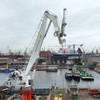Earlier this year, two major shipbuilding associations merged, the National Shipyard Association (NSA), of which Donald "Boysie" Bollinger was chairman; and the Shipbuilders Council of America (SCA), chaired by Daniel L. Gulling, president of Marinette Marine Corp.
NSA had 42 shipyard members and 20 allied/affiliate members before the merger. SCA had nine shipyard and eight allied/affiliate members before the merger. One shipyard held a dual membership.
The new association, which retains the name of Shipbuilders Council of America, now 49 shipyard companies and 30 allied/affiliate members, which own and operate more than 100 shipyards in 20 states. The shipyard members employ approximately 35,000 shipyard workers.
Marine News: What was the impetus for the merger?
Donald Bollinger: Merging the SCA and the NSA just made sense. The two organizations, for the most part, represented shipyards that were similar in terms of size, business portfolio and agendas. Simply put, there was just no reason to have two national shipyard associations representing the shipyard industry that builds and repairs commercial vessels and small government craft.
MN: What legislative issues are of the most concern to the association?
DB: Obviously, SCA believe strongly that our domestic cabotage laws should be maintained. We must protect the U.S.-build provision in the Jones Act and in the Passenger Vessel Services Act. We are concerned the Title XI Loan Guarantee Program has sufficient funding. As you may know, the Title XI program is the only federal government program that encourages vessel construction in U.S. shipyards.
We are also involved in the effort to ensure the ad valorem duty on ship repairs performed on U.S.-flag vessels overseas is not harmed. In addition to the purely legislative issues, SCA is heavily involved with the EPA and OSHA to ensure regulations harmful to industry are not enacted.
We have a policy of working cooperatively with these agencies to ensure shipyards are safe and environmentally sound, but that regulations are not unjustly burdensome on the industry.
MN: What pending legislation is of concern to the association?
DB: So far, in the 106th Congress, a couple of bills have been introduced that we are concerned about. The first has to do with the Passneger Vessel Services Act, the law that requires the carriage of passengers between U.S. ports be done so on U.S.-flag, U.S.-built vessels.
Rep. Mark Stanford (R-S.C.) introduced H.R. 248, Cruise Tourism Act, on January 6. This bill, if enacted, would permit foreign-built and flagged cruise ships to operate between U.S. ports. These vessels would not have to live under U.S. labor, tax or environmental laws, which would put them at an extreme advantage over Americans in the same trade living under our tax and regulatory laws. We expect other PVSA legislation will be introduced in the coming months.
Also, Rep. Frank Wolf (R-Va.) has introduced H.R. 316, which would amend current law to require states specifically pass legislation to allow gaming vessels in and out of their ports. As currently written, the law states gaming vessels may operate unless states pass a law specifically prohibiting them.
We also expect Sen. Sam Brownback (R-Kan.) to introduce legislation to repeal portions of the cabotage provisions in the Jones Act in the near future.
On a positive note, Sen. Mike Enzi (R-Wy.) has introduced S. 385, the Safety Advancement for Employees Act of 1999, which seeks to reform OSHA and provide more consultation programs and technical assistance programs.
MN: What action does the association plan to take to address these concerns?
In general, SCA makes all the members of the House and Senate, in which an SCA member has a facility, aware of our position of any issue in writing. We then follow-up with staff by phone or in person to further educate Congress on our position, and why we've taken that position. We also try to utilize shipyard member relationships with individual members of Congress. We also distribute our newsletter, which states our positions to all members of Congress. We take other action as necessary.
One concern we're currently working on is actively seeking a funding increase for the Title XI loan guarantee program for FY 00.
MN: What legislative issues are the most beneficial to the association?
DB: Because almost all foreign governments subsidize their shipyard industries, provisions in the Jones Act and the Passenger Vessel Services Act that protect our industry (which is not subsidized) against unfair foreign competition are vital to the continued success of American shipyards. The Title XI program is also extremely important to our industry, both for new vessel construction and shipyard modernizations. Since the Title XI program was revitalized in 1993, almost four billion dollars of loan guarantees have been approved. Many of these projects would not have been undertaken without the Title XI program.
MN: What benefits does the merger create?
DB: The merger created one unified trade association representing this sector of the industry. It gives the unified association a broader membership base, which translates into more influence over policy decisions. It also creates a forum in which the whole industry can come together to make decisions, develop agendas and devise strategies to carry out industry agenda. It also brings together shipyards from all areas of the country to discuss issues of importance in each area - both legislative and regulatory concerns.
MN: What weaknesses does the merger eliminate?
DB: Before the merger, there was confusion among policymakers, both in Congress and the Adminstration over which association was the true representative of our industry. The merger eliminates this confusion. It also greatly reduces the ability of those with differing goals and agendas to pit one facet of our industry against another. The industry now has one voice.
MN: What weaknesses does the merger create?
DB: I honestly cannot see how this merger creates any weaknesses. It's a win-win for all our commercial shipyards.
MN: What sector of industry benefits the most from the merger?
DB: The merger benefits the sector of the industry we represent, because it gives the association more legitimacy. For example, we now represent the vast majority of American shipyards involved in mid-sized and small vessel construction. We can now bring together the whole commercial industry in support of issues that primarily affect these shipyards, and vice versa. The newbuild yards put their weight behind issues that primarily affect ship repair operations. And our broader membership base gives us more power to influence the issues affecting the entire industry.
MN: What are the near-term items of business for the association?
DB: Our first order of business was to do all the administrative functions required when you merge any two entities. For the most part, this has been accomplished. We held our first meeting as the new SCA in New Orleans in January. Each of our committees met and devised their priorities. The association is now working to implement these priorities.
We also made membership recruitment a high priority of the new association. Right now, we represent approximately 70 percent of the universe of shipyards in our sector of the business. We believe strongly the other 30 percent should be members of SCA. They benefit from our work and I believe the real power of any association is based in the breadth of their membership base.
MN: How does the association plan to alleviate those concerns?
DB: Believe it or not, this merger has been a smooth one. I cannot think of a single issue that has come up where any member would question the decision to merge the two associations. We have begun an intensive membership recruitment campaign. There are five or six shipyards that immediately come to mind that should be members of SCA and are not. There are a dozen or so others we will also be targeting for membership soon.
MN: What are the long-term items of business for the association?
DB: I had two goals for myself when I became chairman of NSA last April. The first was unifying the industry under one trade association. That goal has been accomplished. However, I still believe we should focus on building the membership even more. My second goal was to ensure the association was financially stable.
MN: How does the association plan to alleviate those concerns?
DB: I have instituted a policy of building the association's reserves to one-year of operating expenses within five years. We are well on our way to achieving the goal of financial stability. The shipyard industry is a cyclical business, and I believe our long-term planning should take into account downturns in the industry, which may make funding for the association more difficult.
MN: How does the merger increase the scope and power of the association, besides on a lobbying level?
DB: I would not discount the increased lobbying power of the association. After all, the major role of any association is to promote its members' goals and educate the public on the industry it represents, and that's what lobbying is all about.
However, as I mentioned earlier, the merger does bring together the real commercial shipyard industry under one roof. It brings more geographic diversity, which enables the association to offer a forum for a broader exchange of information and ideas.
For example, shipyards in the Pacific Northwest, many times, have found ways to comply with environmental regulations, which can prove useful to shipyards from other areas of the country.
MN: How does the new association plan to market to the industry?
DB: SCA is developing a new home page on the Internet. We have also developed an insurance program that will be available only to member companies. This program will offer broader insurance coverages for less money than most shipyards can otherwise buy on their own.
Our membership recruitment efforts are focused on shipyard-to-shipyard communication. By this, I mean shipyard CEOs from SCA member companies are contacting CEOs from non-member companies to explain the benefits of membership.
Having said all this, I believe the only way our marketing will succeed is for the association to succeed. If SCA is successful in achieving the goals of the shipyard industry, members will come. If we keep the current members happy, other shipyards will see the benefit of membership.
Featured videos

AI to the Rescue: Zelim’s ZOE to be Installed on Cruise Ship

Xenos Marine Takes Aim at the Gulf Salvage, Decommissioning Markets
April 2025
 Read the Magazine
Read the Magazine

 Read the Magazine
Read the Magazine
This issue sponsored by:

OPINION: Hold the Bricks, Start the Discussion on the Future of Domestic Shipbuilding
Subscribe for
Maritime Reporter E-News
Maritime Reporter E-News is the maritime industry's largest circulation and most authoritative ENews Service, delivered to your Email five times per week









